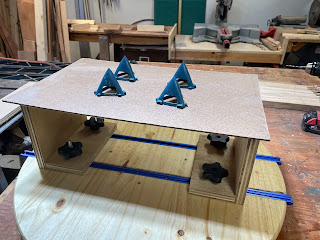For a bit of background on Marc Madore, I'm quoting direct from author (esp. Modern Atlantic Salmon Flies; first and second editions) Paul Marriner's Facebook page celebrating the life of Marc Madore:
A Dark Montreal tied in 1958 led to an estimated 250,000 more flies from the vise of Marc Madore. Marc joined the Canadian Armed Forces in 1961 and spent most of his career in Canada and Germany. Along the way, he jumped from scores of perfectly good airplanes, experiences his knees would later regret.
During a posting to Gagetown, Marc perfected his hairwing and spun deer-hair techniques under the tutelage of the late Garnet “Red” Tweedy, from nearby Burton. Next he tackled the classics and credited World Champion salmon-fly tier Jerome Molloy with polishing his technique. In 2001, Marc’s reputation led to a commission to create a Miramichi Valley fly to be presented to the Queen and other members of the Royal Family, and later Presidents Bush. The result was the Miramichi Viking. In 1995 Marc and his wonderful wife Line retired to Blackville, NB on the banks of the Main Southwest Miramichi. From ‘95 to 2003 he tied more than a thousand dozen flies each year. Clients included LL Bean, WW Doak, Curtis Miramichi River Outfitting, and a list of fortunate individuals. After 2003 Marc sporadically tied commercially but spent most of his time at the vise helping others and working on new design and material ideas.
A score of original, successful, Atlantic salmon patterns emerged from Marc’s Regal. Top producers include the River Prawn series, Madorabou Assassin series, Canadian Black Dose, and the Dart series.
I never met Marc Madore, but through the good offices of my friend Royce Stearns of Oregon City, Oregon, I have met a delightful sampling of Marc's flies. Marc, who spent most of the last years of his life in Blackville, NB, Canada, passed away in 2014, but in the years preceding that time, he developed a friendship with Ronn Lucas, Sr. of Milwaukie, Oregon. Ronn, who passed away in 2023, was an extremely creative fly tyer and fly hook maker and also had a small business selling fly tying materials.
Marc used to send Ronn flies he tied, demonstrating not only his incredible talent as a tyer, but also the broad spectrum of Atlantic salmon flies he tied, along with comments and letters talking about flies and fishing for Atlantic salmon. Lucas kept all of Marc's gifts, and at his (Lucas') passing in 2023, his estate began to disperse the vast fly collection he had amassed. My friend Royce is one of the experts helping to disperse that collection in a meaningful way and knew of my interest in Miramichi-related flies particularly, and of my connection to The Atlantic Salmon Museum in Doaktown, NB (I'm VP of the board there).
I agreed to accept the fly collection and correspondence on behalf of that Museum. To ensure the safety of the collection, Royce and I agreed that it would be best to wait 'til I was back in Vermont for the winter before sending it to me. Suffice it to say, I was blown away as I slowly unpacked the flies and read the correspondence. What a treat for this old fly tyer! So here, with very little interpretation from yours truly, is what will be heading for the Atlantic Salmon Museum (my intent is to frame as much of it as possible to make it safe and easy to display.)
Marc created some delightful little vignettes of the basic steps in tying a few different flies, particularly what are generally called buck bugs (spun deer hair bodies...hence the "buck")
Click on the pics for larger versions!
Green Machine (the fly I love to hate):
White/Orange Bomber
Yellow Buck Bug
I continue to enjoy tying vintage strip wing salmon fly patterns. Marc was a Master:
Another
vignette:
An interesting letter (talks about tying flies for George Bush and more):
I believe this is the set of flies he's referencing in his letter to Ronn:
Marc and Marabou:
His streamers are the stuff fly tyers dreams are made of!
And then there are the shrimp patterns! Note those are all on blind eye hooks!
Showing off Lucas' iridescent dubbing:
Royce Stearns brought these comments and recipes of Marc's from the old FAOL website to my attention:
Very helpful link right there, thanks Royce!
From the folks I've talked to about Marc, he gave freely of his expertise, and helped a great many people become better fly tyers. A photo of Marc behind the vise, from Paul Marriner's Facebook page (BTW, Paul is an important chronicler of fly tyers that have made a difference, and I've been using his book,
Modern Atlantic Salmon Flies, since the day I started tying salmon flies. He generously gave permission to quote from his page and use the photo:
That man could certainly tie a fly. Cheers,





















.jpg)























